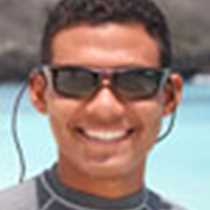This morning we visited Academy Bay where the largest town of Puerto Ayora is located, population 18.000. At 6:00 a.m. the highlands looked overcast and rainy, while in the opposite direction the sun started to rise into the sky, making a beautiful rainbow at the horizon. At 8:00 a.m. we disembarked on the municipal dock to start our explorations of the day. We headed first to visit the Darwin Foundation and the National Park breeding program of Galápagos giant tortoises. There we had the chance to see them in several corrals for breeding and studying from the time they come out of the egg until they grow enough to be taken back to their original island to restore their dynasty. In the past these incredible reptiles were food for pirates and visitors and nowadays they face other threats such as feral pigs and black rats that decimate their population.
In this area our explorers got to see and to identify many of the species of Darwin's finches, such as common cactus finches, vegetarian finches, small, medium, and large ground finches. We learned about the biological control we use to get rid of many alien species that are affecting their population, which is the case of the mangrove finch which is in danger of extinction.
Later our guests went to visit the town to learn more about the people living in the Galápagos Islands. Up in the mountains we visited a local family of farmers that are self-sufficient in their way of surviving, getting all their food supplies from mother earth. The Trapiche is the name of their farm and there we were able to see how they produce sugar-cane, brown sugar, melaza, and coffee.
After lunch we went to visit the area of El Chato, which is the reserve of giant tortoises in the wild. There is a great panoramic view of the west side of the island, the lush green vegetation covered by grass, and tons of giant tortoises walking and feeding everywhere in their natural environment. Tortoises are big creatures that have evolved in isolation and nowadays 10 species of them are distributed on several islands. In this case we are looking at a very unique type of tortoise only found in Santa Cruz, which is a dome-shaped morpho-type. Before leaving this location we had the chance to actually get under the earth, inside a lava tunnel, which gave us a new perspective of the island’s geological formation.
After visiting this island we headed back to the National Geographic Islander where we were able to enjoy unique music and artistic dances from local “Galapagueños” musicians with a mix of Andean music.
We were happy to have another beautiful day full of surprises, emotions, explorations, and adventure in the Galápagos Islands.









